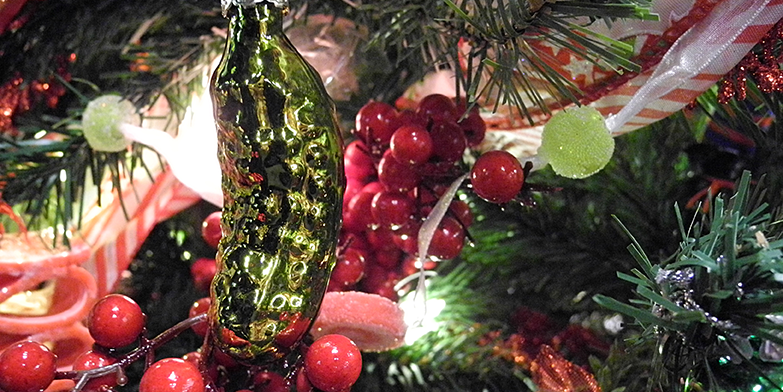Pickle Ornaments on a Christmas Tree Actually Hold a Special Meaning

In many families, Christmas Day starts with a frantic hunt. Kids and adults alike comb the tree for a little, green pickle-shaped ornament hidden somewhere within its branches. The person who finds the pickle gets to open the first present, and gloat about it until the next year. It starts the day off with a lot of laughs and a little friendly competition; just the way some clans like it. It also means you'll have good fortune in the year ahead! But many don't know where the pickle came from—just that it's been in the family as long as anyone can remember. So we dug into the history behind the Christmas pickle, and what about it keeps us hunting to this day.
The Christmas pickle has vaguely German origins
During the 1880s, the department store Woolworths began selling blown-glass ornaments imported from Germany, some of which were shaped like fruits and vegetables. Around that same time, a story began circulating that German people hung a pickle on their tree as the last ornament. The first child to find the pickle got to open an extra present. But when Americans checked in with the Old Country, most Germans had never heard of the tradition. Common wisdom has it that some savvy salesman made up the tale to sell more pickle ornaments, and if today's trees are any indication, it seems to have worked.
Two legends explain the pickle
If there's one thing we know about Christmas, it's that legends abound. One of them posits that a German soldier who was a prisoner of war during the American Civil War begged a guard for a pickle to stave off starvation. The guard complied, and it gave him the strength to carry on.
In the other tale, two Spanish boys were traveling back home for the holidays when they stopped at an inn. The evil innkeeper killed them and stuffed their bodies in a pickle barrel. When St. Nicholas happened upon that same inn, he found the boys and magically brought them back to life.
A Michigan town has more ties to the ornament than Germany
If you really want to trace the pickle back to something concrete, look no further than Berrien Springs, MI. Neither of these aforementioned tales stand the test of time nearly as well as an excess of pickle ornaments at Woolworth's, according to the Berrien County Historical Association Executive Director Rhiannon Cizon.
"Germans (and several eastern European countries) do have a love for fermented or pickled foods, so it's not a surprise that the two are so intralinked in people's minds," she explained. Thanks to fertile farmland and a large German community, Berrien Springs was once known as the Pickle Capital of the World.
The community was so committed to the fermented vegetable that they held a Christmas pickle festival from 1995 into the 2010s, complete with a parade, pickle pageant, pickle-tossing competitions, and a pickle-eating contest. The event kicked off the holiday season, and probably sold a lot of ornaments, too. While the festival is no more, the people of Berrien still have a pickle-shaped place in their hearts for the ornament.
"Maybe someday the Grand Dillmeister will walk the streets of Berrien Springs again," Cizon says. "But until then, we have the shine of our favorite ornament to keep the spirit of Christmas pickles alive."

